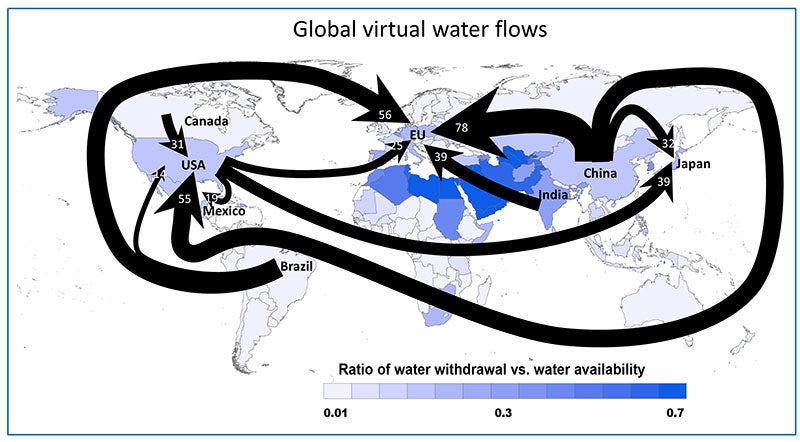Note: Yale School of the Environment (YSE) was formerly known as the Yale School of Forestry & Environmental Studies (F&ES). News articles and events posted prior to July 1, 2020 refer to the School's name at that time.
Everything, from the food we eat to the clothes we wear to cars we drive, has global implications, requiring resources from distant places and generating pollution far from our homes. But while these impacts have been known for a long time, our understanding of the complex ripple effect throughout the global economy and on natural and social systems remains rudimentary.
In a new special issue, “Linking Local Consumption and Global Impacts,” Yale’s Journal of Industrial Ecology examines the virtual shrinking of distances between places — arising because of trade, telecommunication and travel — and the widening gap between where products are made, where they’re used, and where the impacts occur.
In a new special issue, “Linking Local Consumption and Global Impacts,” Yale’s Journal of Industrial Ecology examines the virtual shrinking of distances between places — arising because of trade, telecommunication and travel — and the widening gap between where products are made, where they’re used, and where the impacts occur.

The articles link consumption and/or production activities to a wide range of environmental impacts, including water, energy and land use; various pollutants; and economic and social indicators, such as child labor, social costs of carbon, and loss of human life.
“The focus is on ‘tele-connected systems,’” said Prof. Klaus Hubacek of the University of Maryland and lead guest editor for the special issue. “This is a concept from atmospheric sciences referring to climate phenomena being related to one another at large distances. Recently, this idea has been used to represent the strengthening of connectivity between distant locations and, at the same time, the growing physical separation between places of consumption and production.”
Highlights of the issue include:
“Much of the research in this special issue uses a technique called environmentally-extended multi-regional input-output analysis.” said Reid Lifset, Editor in Chief of the Journal of Industrial Ecology. “This method, a hallmark of the field of industrial ecology, is especially well-suited for linking the local to the global because it allows tracing of supply chains and the attendant resource use and emissions within and across countries.”
The Journal of Industrial Ecology is a peer-reviewed international scientific journal owned by Yale University and headquartered at the Center for Industrial Ecology of the Yale School of Forestry & Environmental Studies.
Articles in the special issue are freely downloadable for a limited time.
“The focus is on ‘tele-connected systems,’” said Prof. Klaus Hubacek of the University of Maryland and lead guest editor for the special issue. “This is a concept from atmospheric sciences referring to climate phenomena being related to one another at large distances. Recently, this idea has been used to represent the strengthening of connectivity between distant locations and, at the same time, the growing physical separation between places of consumption and production.”
Highlights of the issue include:
- An assessment of the impacts of the 21st century Great Recession on income inequality and households’ carbon footprint.
- An examination of the global implications of China’s future food demand
- Tracking of water footprints at the micro- and meso-scale through combining MRIO (multiregional input output analysis) and geographical information system (GIS)
- An assessment of child labor’s role in Indian production and global consumption
- A look at the unequal carbon exchanges of iconic U.S. consumption items
- Discussion on the role of trade openness in the context of climate-change mitigation
- An analysis of households’ direct and indirect material, water, and land use requirements and GHG emissions
- Research that links a consumer expenditure survey to a global MRIO database to assess the carbon footprint for different household categories
- A global framework for reconciling top-down with bottom-up approaches for identifying and evaluating the effectiveness of different scenarios about the future
“Much of the research in this special issue uses a technique called environmentally-extended multi-regional input-output analysis.” said Reid Lifset, Editor in Chief of the Journal of Industrial Ecology. “This method, a hallmark of the field of industrial ecology, is especially well-suited for linking the local to the global because it allows tracing of supply chains and the attendant resource use and emissions within and across countries.”
The Journal of Industrial Ecology is a peer-reviewed international scientific journal owned by Yale University and headquartered at the Center for Industrial Ecology of the Yale School of Forestry & Environmental Studies.
Articles in the special issue are freely downloadable for a limited time.
Published
July 6, 2016